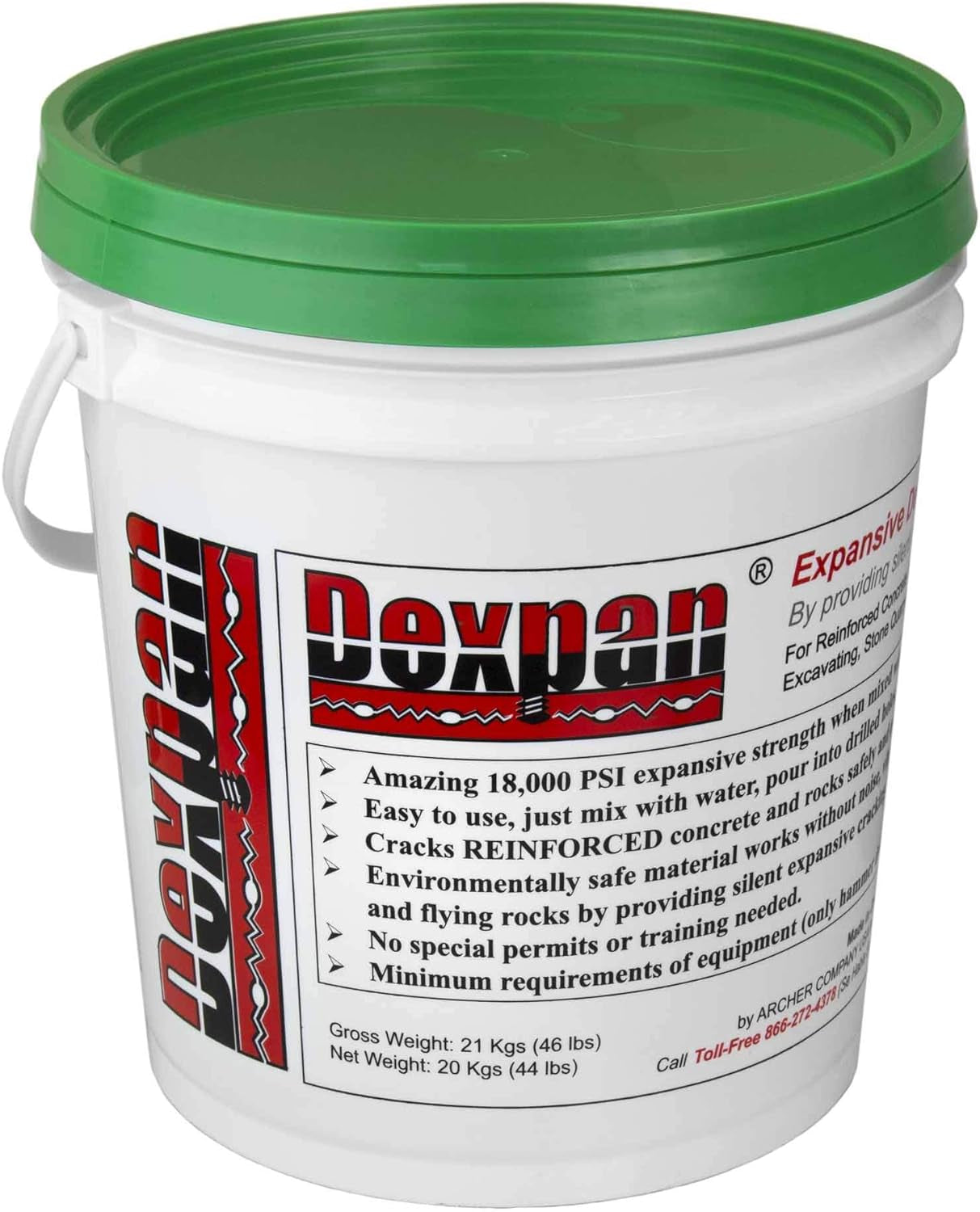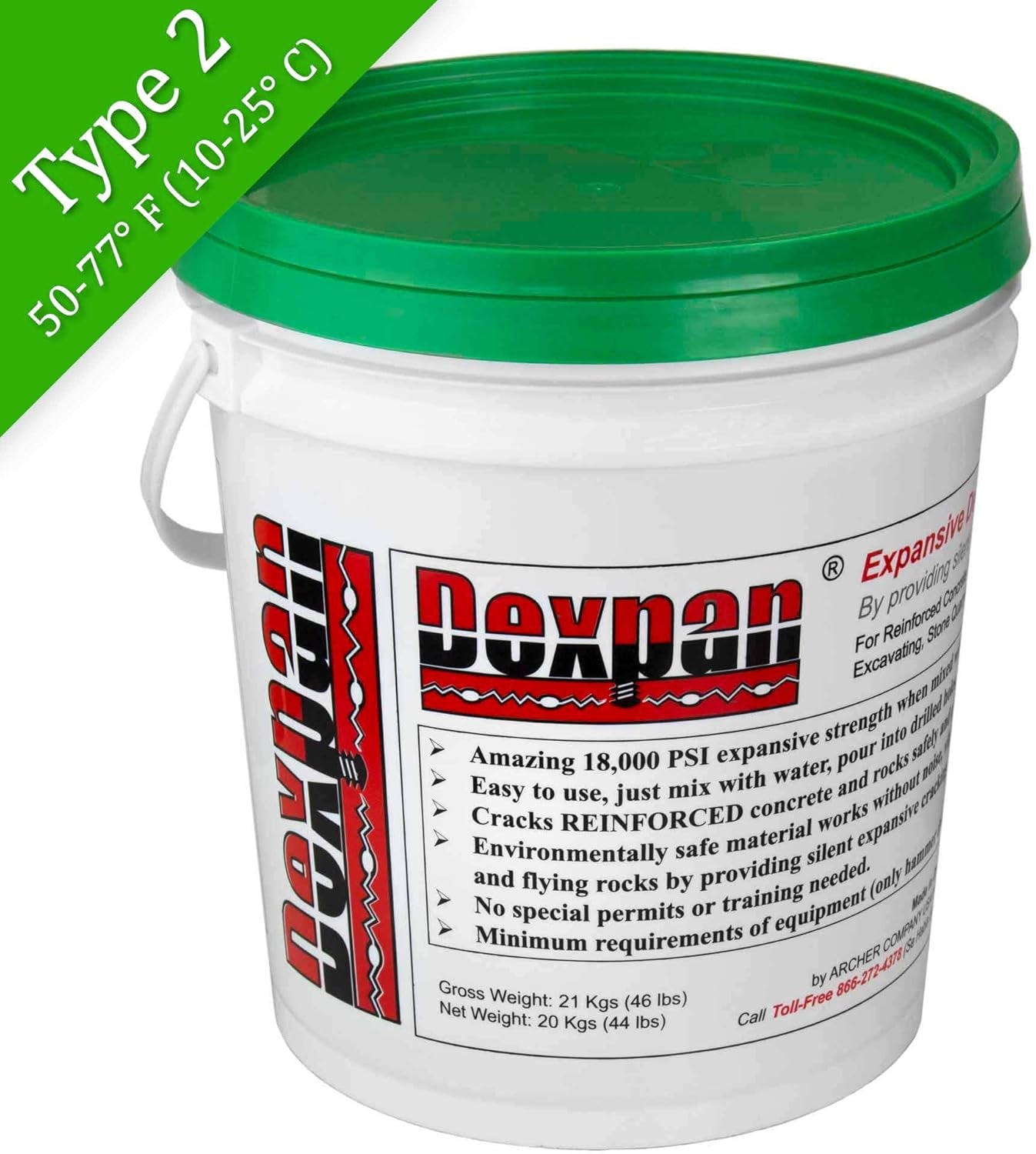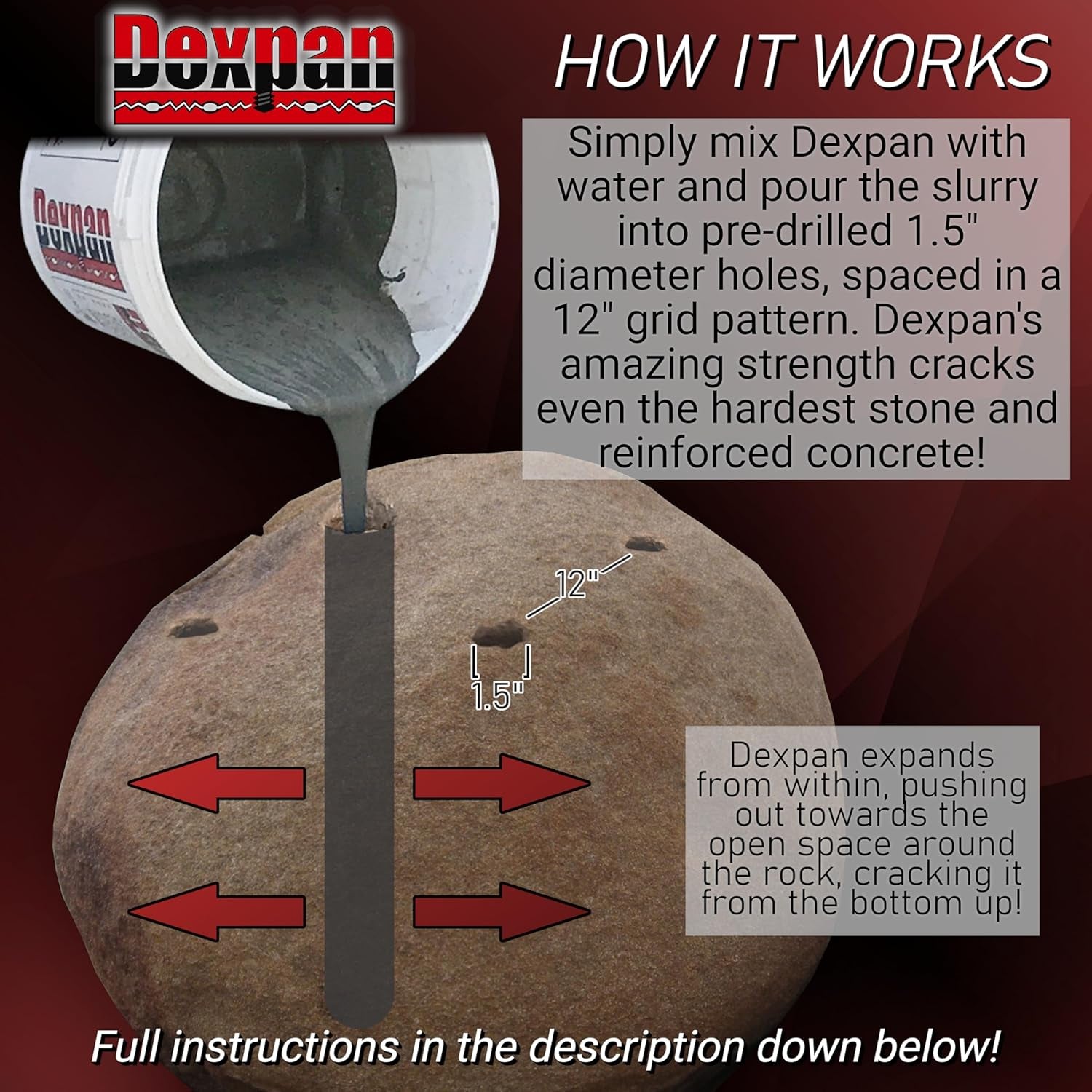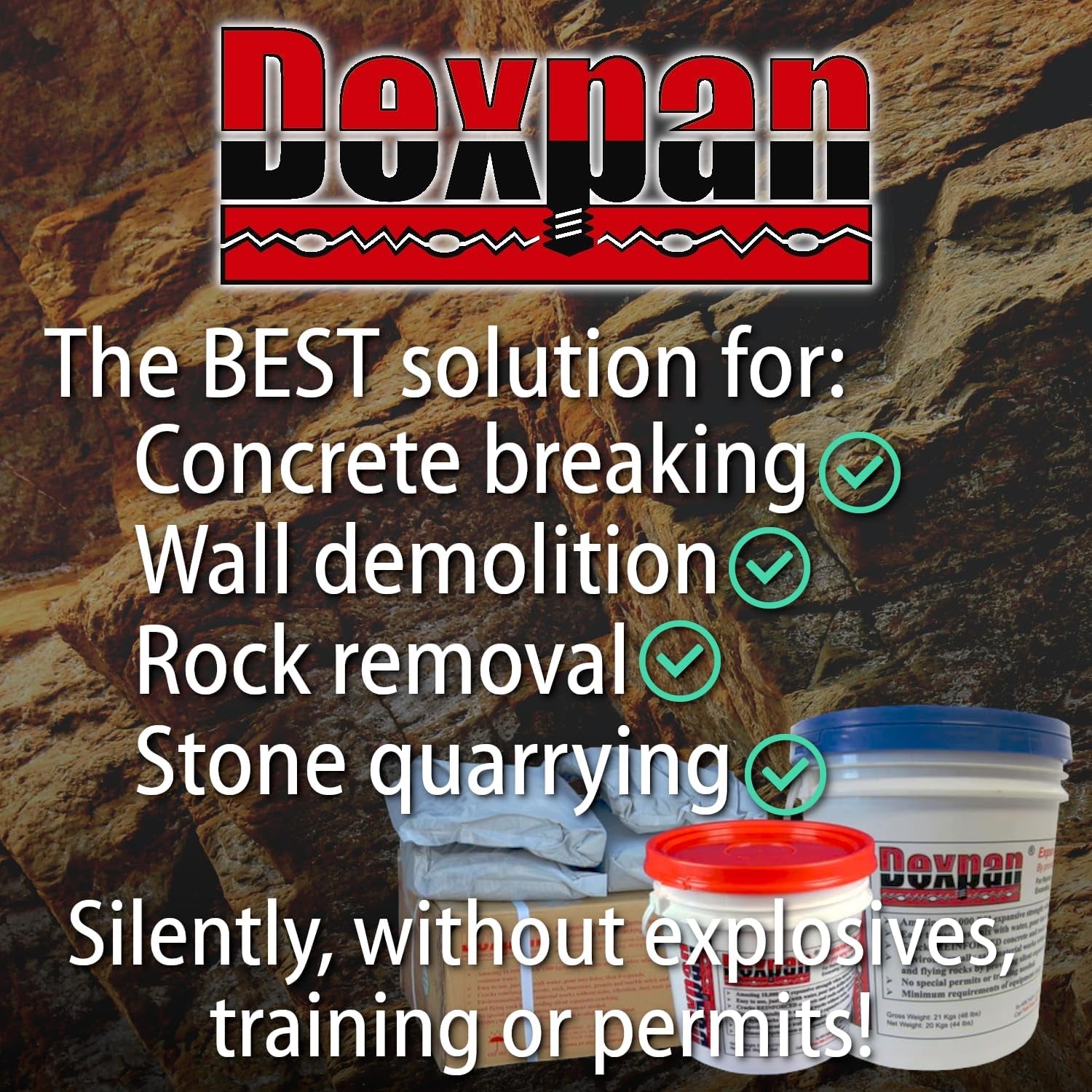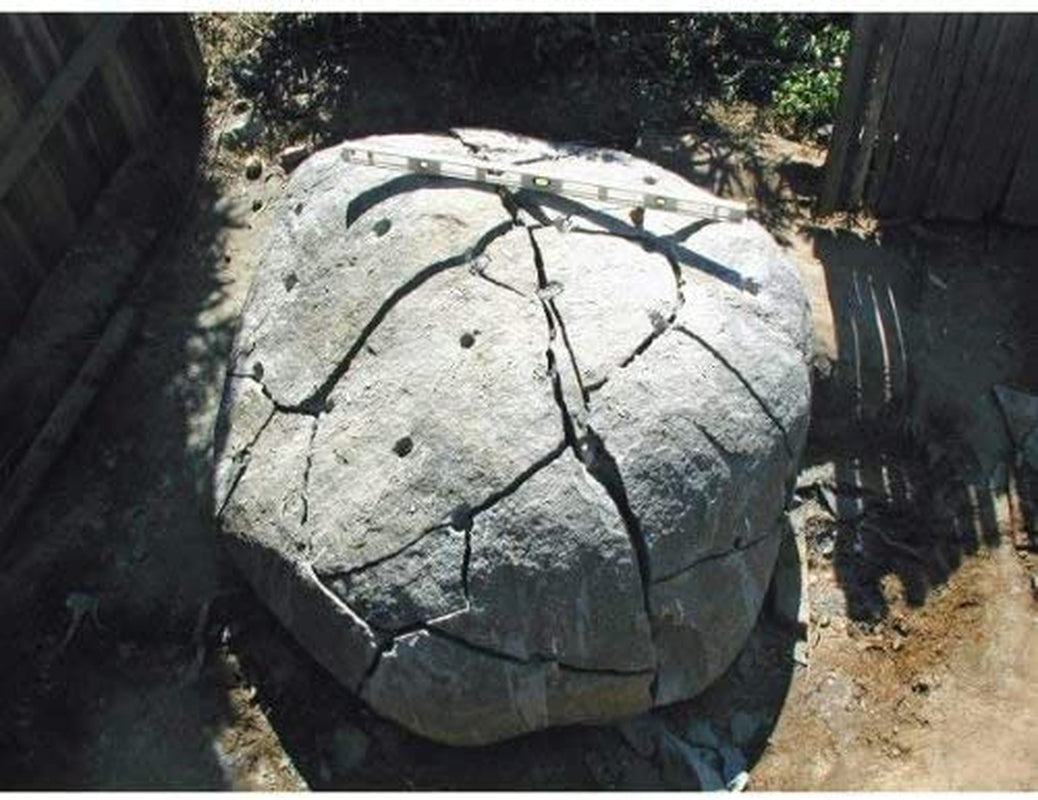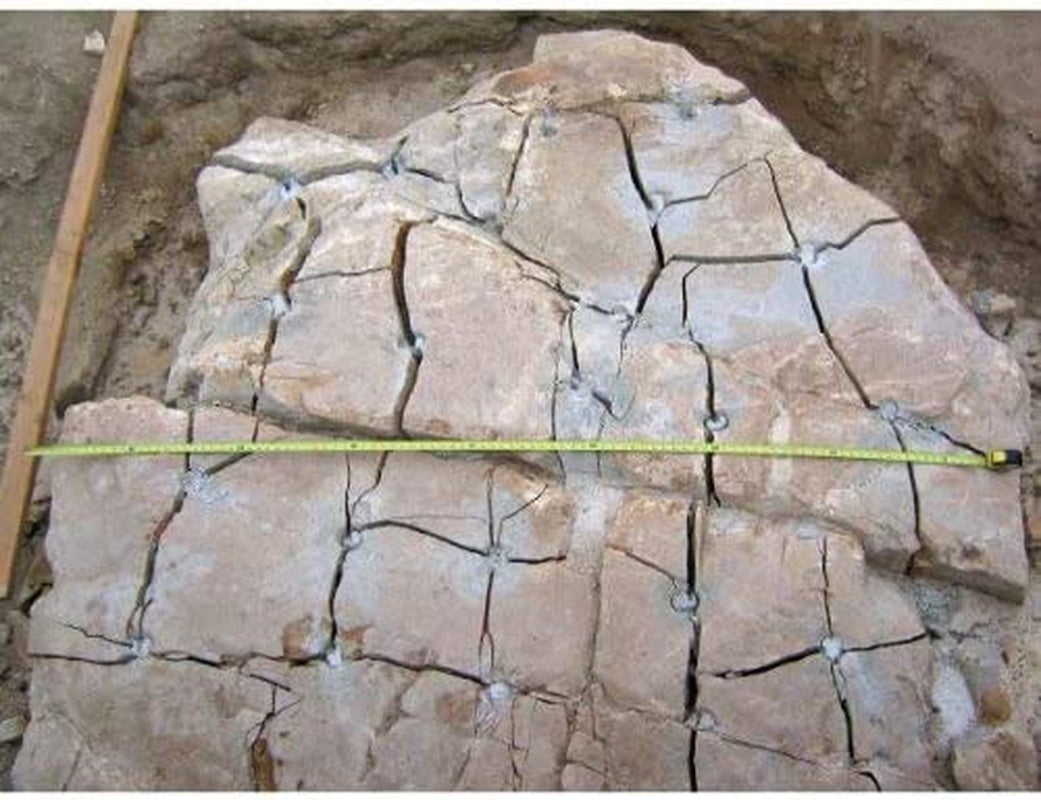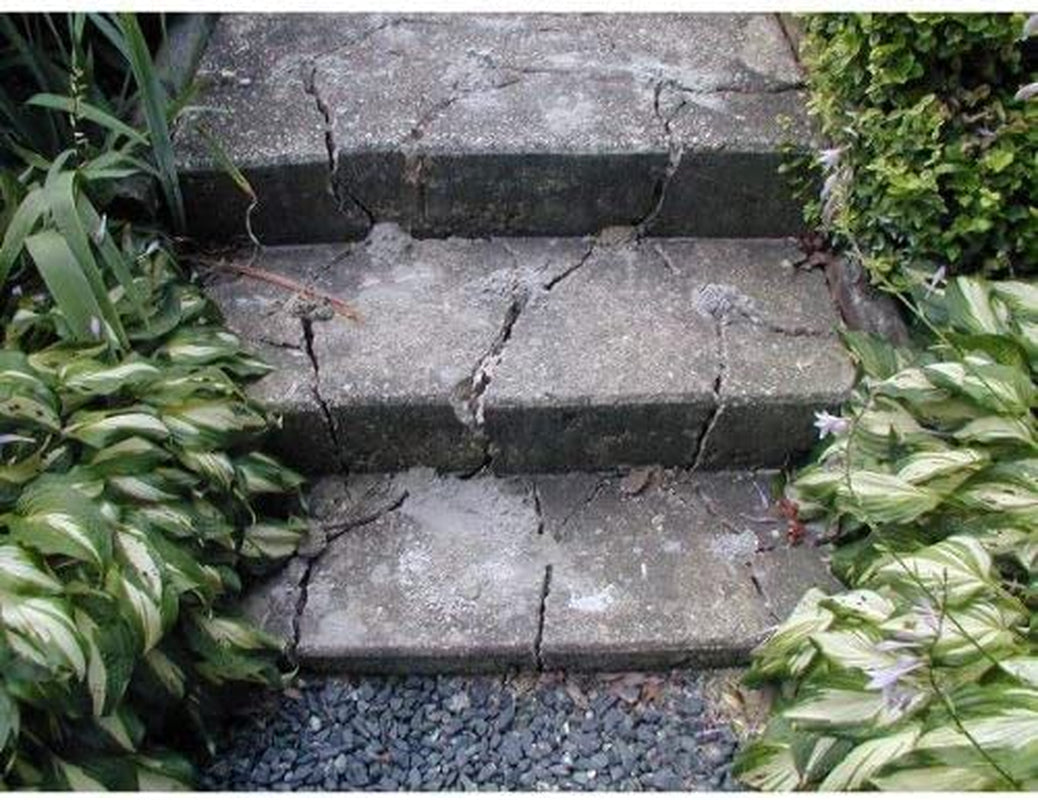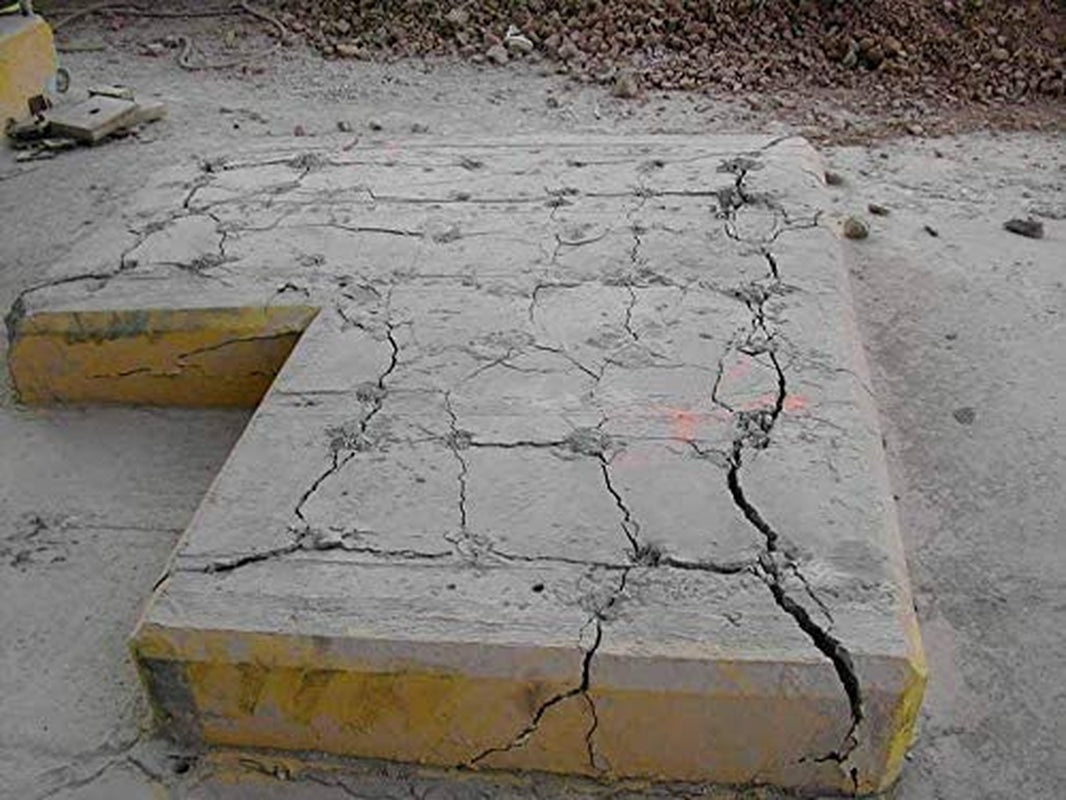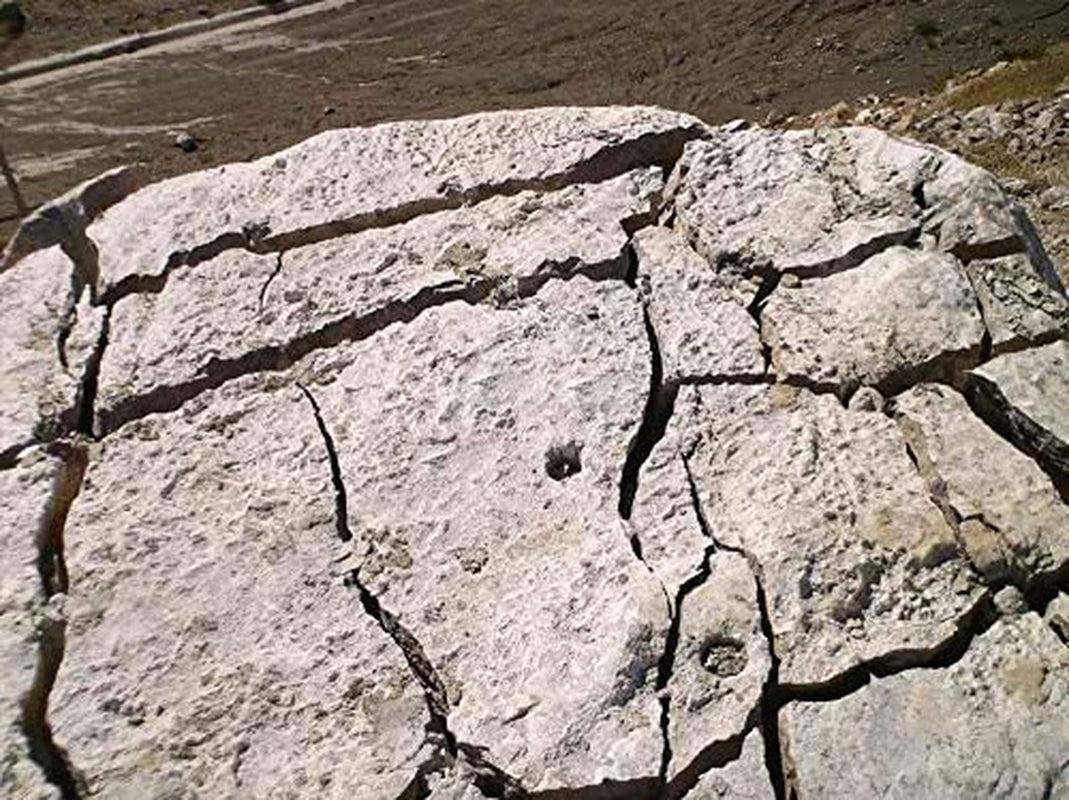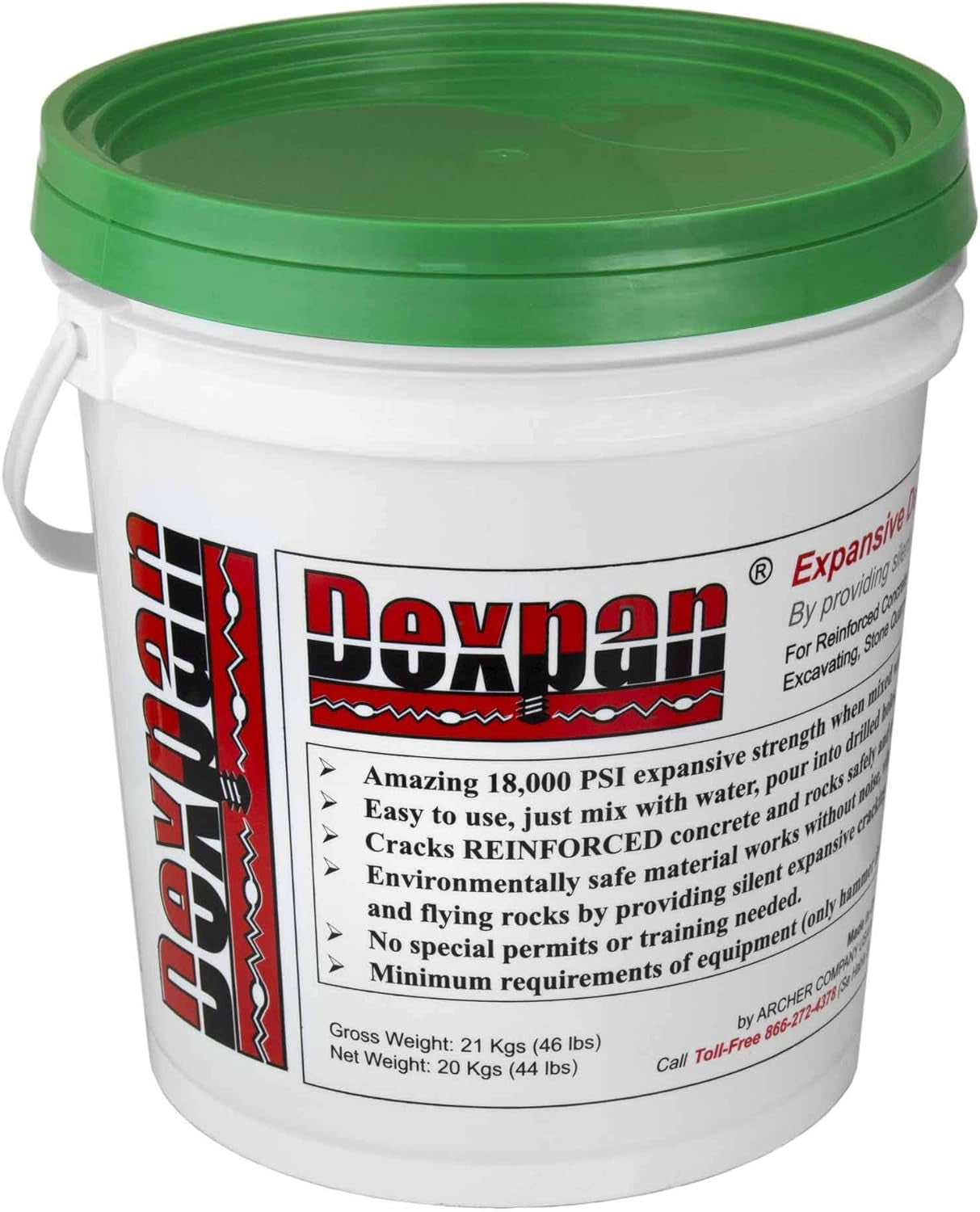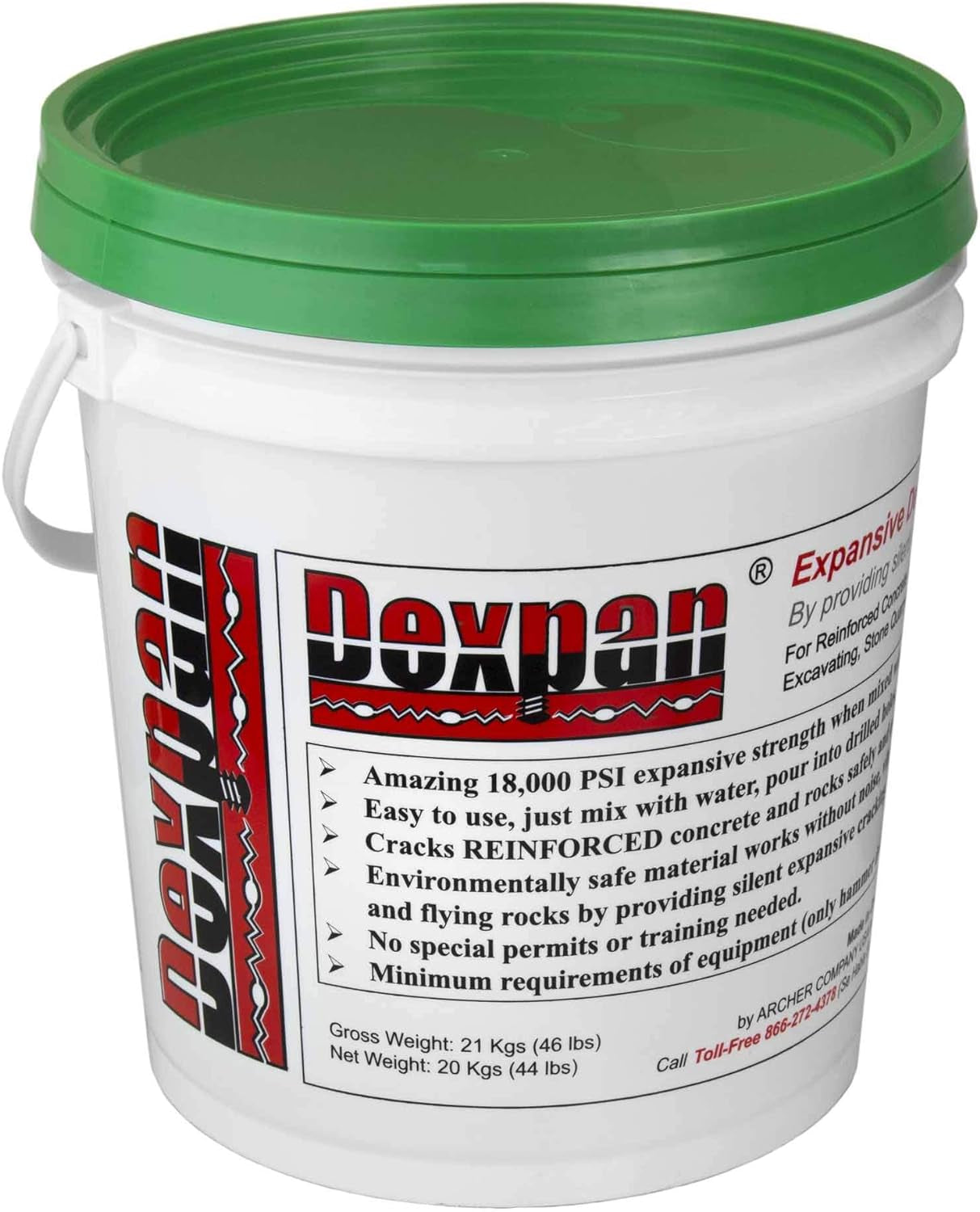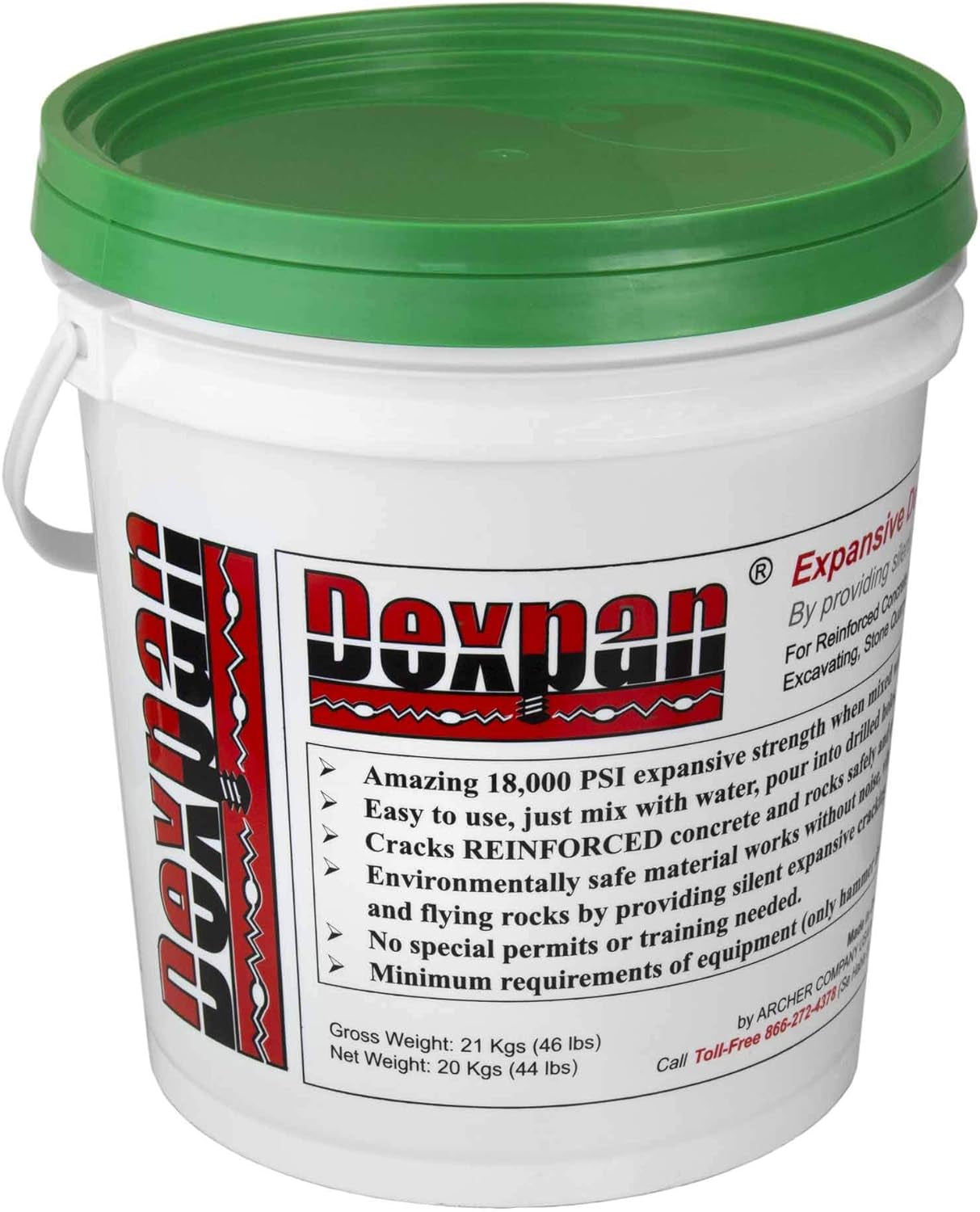- Concrete Demolition and Rock Breaking has never been EASIER! 3 Easy Steps to use: Drill, Mix, Pour.
- Amazing 18,000 PSI expansive strength when mixed with water. Cracks according to drilling patterns.
- Dexpan breaks Reinforced Concrete & Rock WITHOUT Noise, Vibration! SILENT Controlled Demolition.
- Hundreds of job photos! Alternative to demolition jack hammer breaker, jackhammer, diamond saw blade.
- Type#2 (Rock, Concrete Temperature 50F~77F). 44 Lb. Bucket fills up to 35 linear ft. of 1.5 in. holes.
Product Description
Dexpan Non-Explosive Demolition Agent for Rock Breaking, Concrete Demolition Removal and Stone Quarrying
Alternative to Blasting, Demolition Jack Hammer Breaker, Jackhammer, Diamond Blade Concrete Saw, Rock Drill, Concrete Breaker, Rock Breaker
- Are you the DIY home users trying to break huge rocks? Jackhammer won't work?
- Are you the contractors trying to demolish mass reinforced concrete? Try to prevent damage to heavy equipment?
- Are you the quarry owners trying to avoid waste of valuable stone and increase stone quarrying production and safety?
Concrete demolition removal, rock breaking and stone quarrying has never been easier with Dexpan Non-Explosive Demolition Agent. Dexpan is a cement with amazing 18,000 psi expansive strength when mixed with water. Poured into pre-drilled holes, Dexpan can break concrete and rocks safely and quietly, while providing silent cracking. It is safe, easy and cost effective. AKA Dexpan Expansive Demolition Grout, Rock Splitting Compound Chemical.
Benefits:
- 3 easy steps to use: drill, mix and pour.
- Controlled demolition and easy clean up.
- Silent cracking, breaks concrete and rock without noise, vibration or dust
Concrete removal, rock breaking and stone quarrying has never been easier with Dexpan Non-Explosive Demolition Agent
Controlled Concrete Demolition is as easy as Drill, Mix and Pour!
Dexpan cracks according to drilling patterns. Demolition contractors, drilling and blasting contractors can easily break reinforced concrete or rocks into desired sizes and shapes, so they may cut off exposed rebars, haul demolished chunks away with a crane or excavator without damaging the desired remaining parts. Rock breaking and concrete demolition have never been easier and more effective.
Dexpan is capable of demolishing multi-ton weight reinforced concrete structures and rock.
No Noise! No Vibration! Silent Rock Breaking, Removal and Excavating
Dexpan Non-Explosive controlled Demolition Agent can also be applied along with traditional demolition tools like jackhammers, wrecking balls, hydraulic breakers, diamond blade concrete saws, diamond wire sawing machines to help cut cost, work time and increase safety.
Plus because it works as silent cracking, Dexpan is perfect for demolition contractors, drilling and blasting contractors who work in residential, schools, hospitals, airports, and other noise, ground vibration, air blast, dust restricted areas.
Dimensional Stone Quarrying, Avoid waste of valuable stone! Increases Stone Production!
In Mining and Stone Quarrying industry, Dexpan helps to acquire perfect slabs and blocks from limestone, onyx, marble, granite, sandstone, flagstone or many other types of natural stones.
Compared to explosives blasting and detonating cord, Dexpan non-explosive demolition agent avoids waste of valuable stone, high cost of blasting insurance, storage and labor. Not to mention increased safety and stone production.
Compared to diamond wire sawing machines, Dexpan avoids high cost of equipment, replacing diamond wire, complicated setup, relocation and maintenance, there is no limited cutting distance due to length of diamond wire, no cooling water and high voltage power supplies required.
Standard Drilling Pattern
This Drilling Pattern uses Dexpan to its fullest to crack your concrete or rocks into easily removed sections. Space each hole 1-Foot apart from the others, measuring from the center of each hole. Make sure at least one side of the project has free space to expand to equal to the depth of the holes.
Minimal Dexpan Use Drilling Pattern
This Drilling Pattern is designed to use the smallest amount of Dexpan to cleanly split rocks and concrete into sections.
Buried Rock Drilling Pattern
By drilling diagonal holes into the surface of a buried rock, Dexpan can work to push the rock upwards, cracking it into the free space above the rock.
Dexpan Hole Size Comparisons
When using Dexpan, we recommend drilling 1.5-Inch Holes to make the most efficient use of the project. Smaller holes do not contain enough Dexpan to adequately provide force against the rock, and larger holes cause Dexpan to cover a smaller area with the same amount of product.
Standard Drilling Pattern
Minimal Dexpan Use Drilling Pattern
Buried Rock Drilling Pattern
Hole Size Reference
Frequently Asked Questions
How much concrete can I demolish with a box of Dexpan?
A standard 44lb. box will cover approximately 35 lineal feet of drilled holes, which can be used in a standard pattern to remove 60 cubic feet, or 1.7 cubic meters, of concrete. A 11lb. bucket will cover approximately 9 lineal feet, or ~16 cubic feet (.45 cubic meters). Dexpan is recommended for projects with a depth of at least 8 inches.
Which Dexpan should I use?
Use the ambient temperature of the area surrounding the rock and compare it to the temperatures listed on each type of Dexpan. A local weather forecast should be enough to determine the appropriate type of Dexpan. For Temperatures between 77-104° F (25-40° C), use Dexpan #1. From 50-77° F (10-25° C), use #2. And for 23-50° F (5-10° C), use #3.
When should I pour Dexpan?
The best time to pour Dexpan is the morning after you drill the holes, immediately after combining the product with water. Doing this as early as possible will allow Dexpan to work throughout the day.
Dexpan pushed itself out of its hole! What went wrong?
We refer to Dexpan pushing itself out of the drilled hole as a 'blowout', and it can occur for a few reasons. The most common is when the project does not have adequate expansion space. Be sure that there is an empty area next to the rock at least as long as the depth of the drilled holes so that Dexpan has somewhere to push the rock. Blowouts may also occur due to high temperatures (especially when using the wrong Type of Dexpan), large hole diameters, and using Core Bits to drill holes.

